Organisational Behaviour and Performance
VerifiedAdded on 2021/02/21
|15
|4310
|300
AI Summary
Organisational Behaviour INTRODUCTION 1 TASK 11 P1 Impact of organisational culture, politics and power on individual, team behaviour and performance 1 P2 Theories of motivation 5 P3 Explain what makes an effective team as opposed to an ineffective team 7 P4 Concepts and philosophies of organisational behaviour9 CONCLUSION 10 REFERENCES 11 11 INTRODUCTION Organisation refers to a group of people who are workedin collaboration with dedication to achieve common goal. TASK 1 1 P1 Impact of organisational culture, politics
Contribute Materials
Your contribution can guide someone’s learning journey. Share your
documents today.
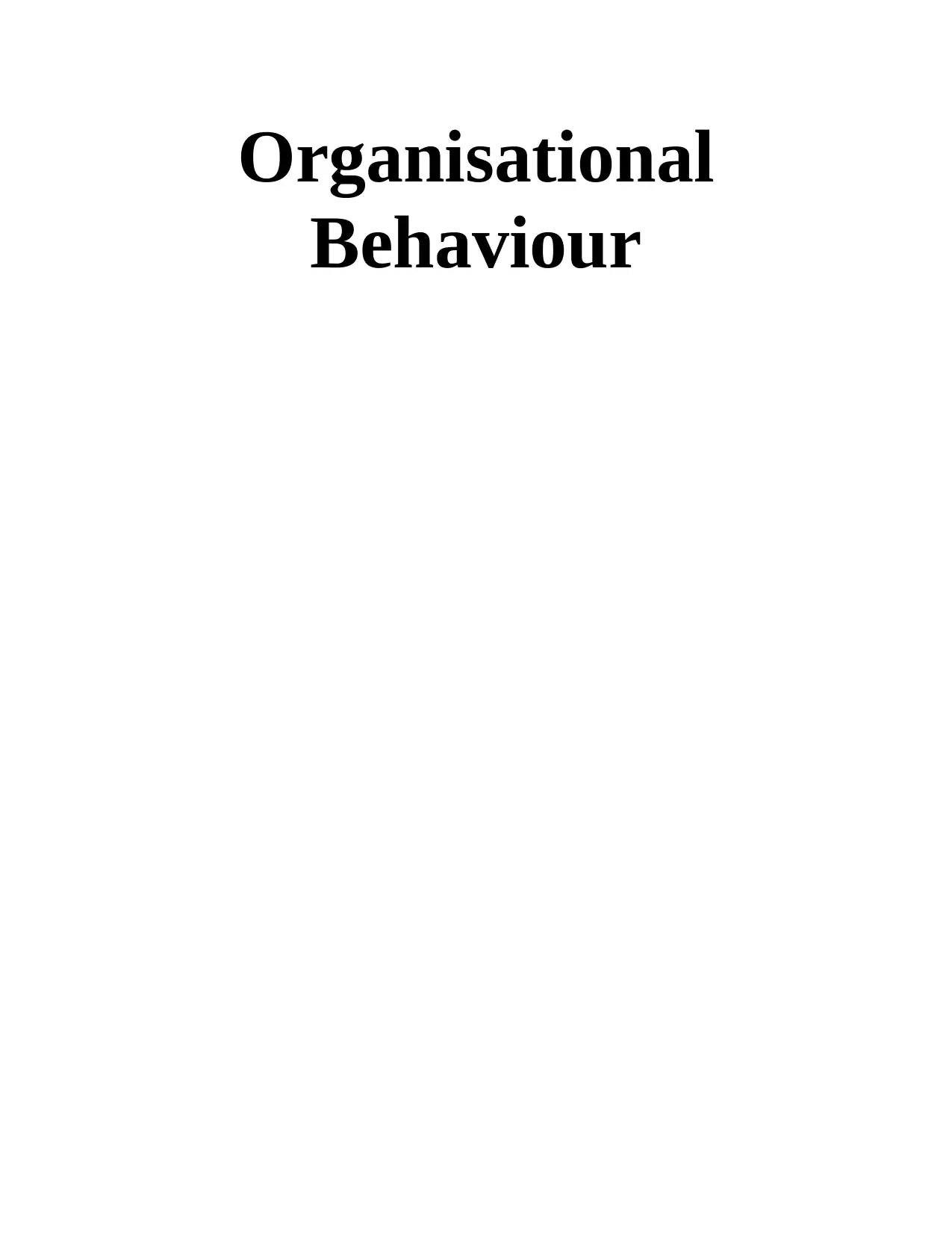
Organisational
Behaviour
Behaviour
Secure Best Marks with AI Grader
Need help grading? Try our AI Grader for instant feedback on your assignments.
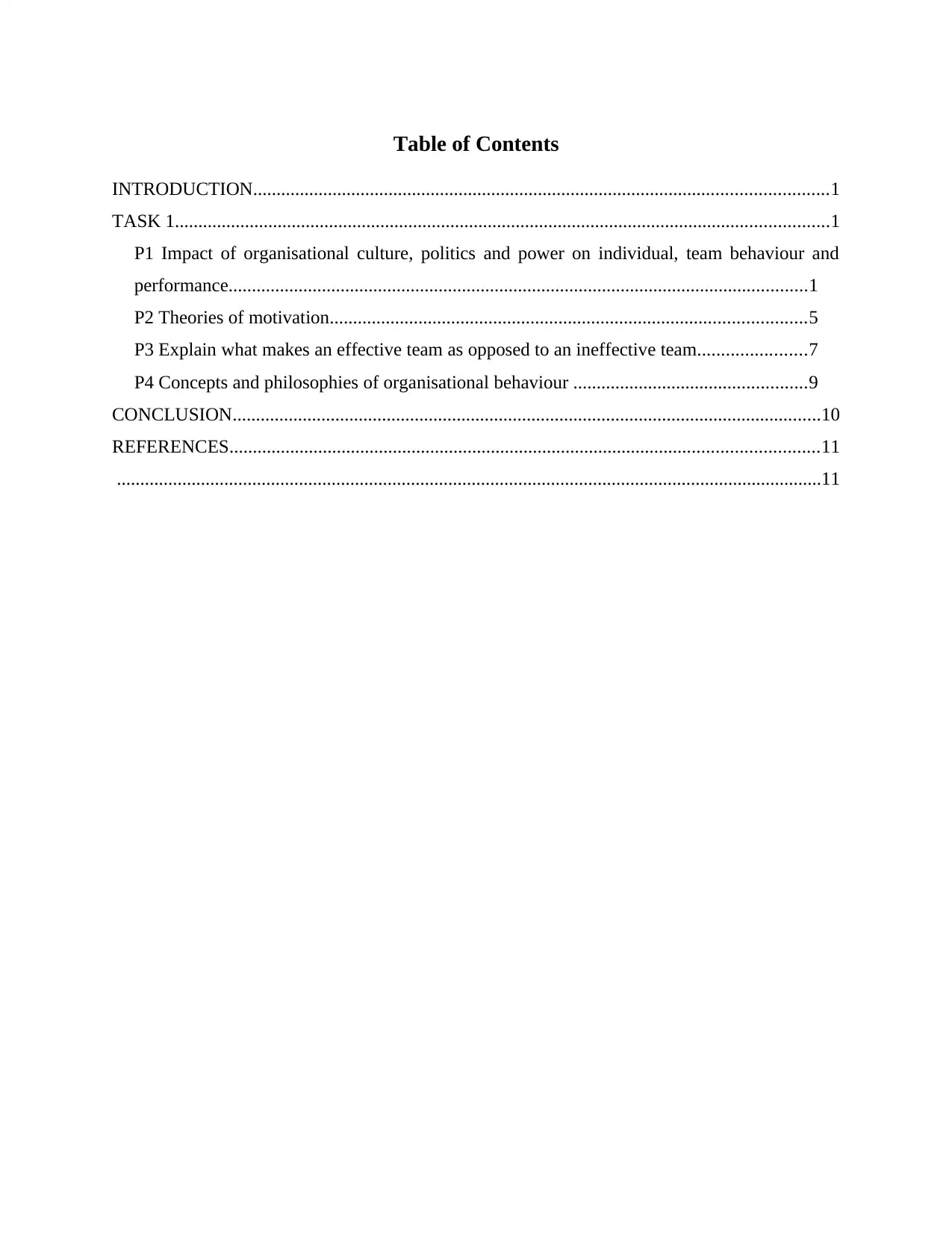
Table of Contents
INTRODUCTION...........................................................................................................................1
TASK 1............................................................................................................................................1
P1 Impact of organisational culture, politics and power on individual, team behaviour and
performance............................................................................................................................1
P2 Theories of motivation......................................................................................................5
P3 Explain what makes an effective team as opposed to an ineffective team.......................7
P4 Concepts and philosophies of organisational behaviour ..................................................9
CONCLUSION..............................................................................................................................10
REFERENCES..............................................................................................................................11
.......................................................................................................................................................11
INTRODUCTION...........................................................................................................................1
TASK 1............................................................................................................................................1
P1 Impact of organisational culture, politics and power on individual, team behaviour and
performance............................................................................................................................1
P2 Theories of motivation......................................................................................................5
P3 Explain what makes an effective team as opposed to an ineffective team.......................7
P4 Concepts and philosophies of organisational behaviour ..................................................9
CONCLUSION..............................................................................................................................10
REFERENCES..............................................................................................................................11
.......................................................................................................................................................11
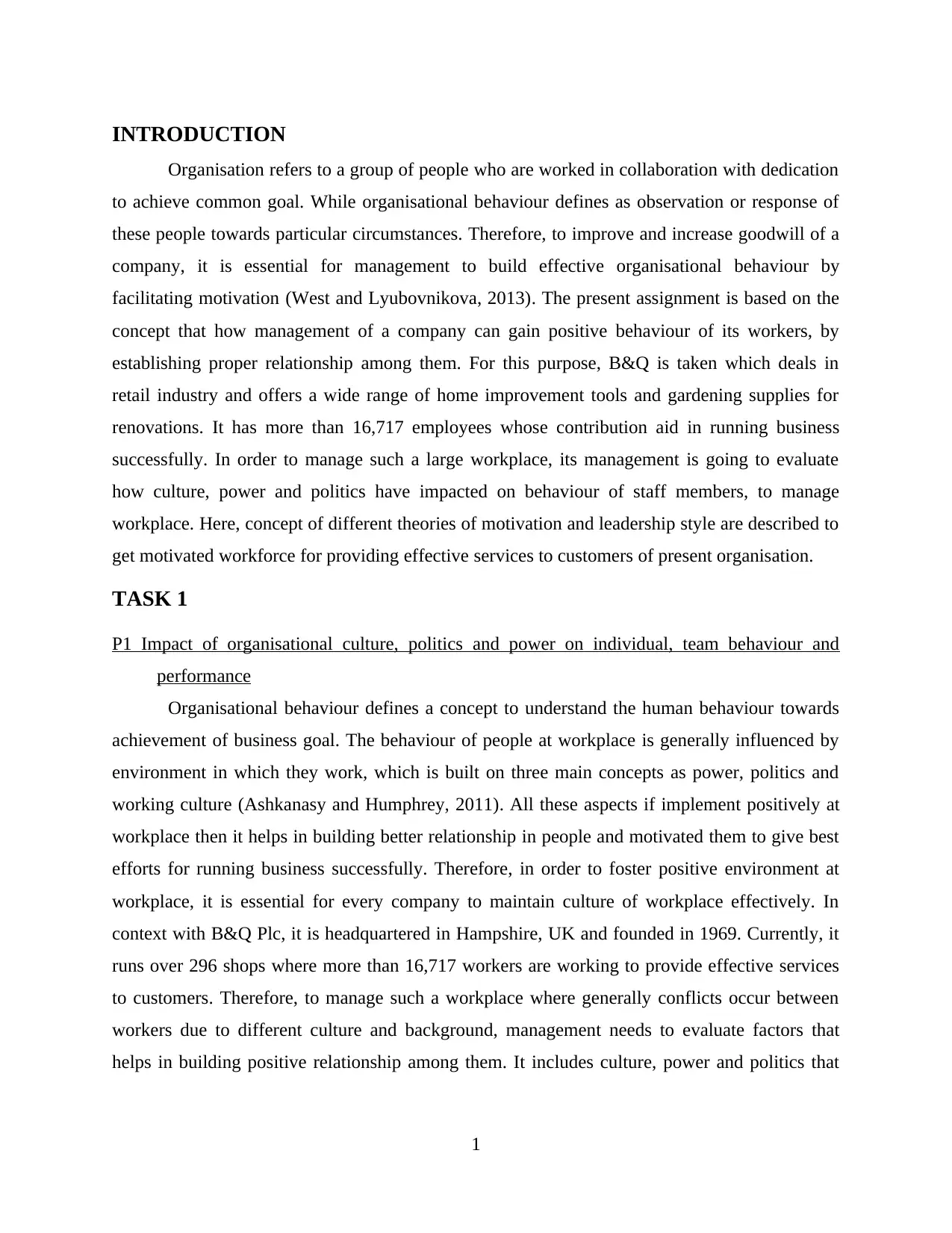
INTRODUCTION
Organisation refers to a group of people who are worked in collaboration with dedication
to achieve common goal. While organisational behaviour defines as observation or response of
these people towards particular circumstances. Therefore, to improve and increase goodwill of a
company, it is essential for management to build effective organisational behaviour by
facilitating motivation (West and Lyubovnikova, 2013). The present assignment is based on the
concept that how management of a company can gain positive behaviour of its workers, by
establishing proper relationship among them. For this purpose, B&Q is taken which deals in
retail industry and offers a wide range of home improvement tools and gardening supplies for
renovations. It has more than 16,717 employees whose contribution aid in running business
successfully. In order to manage such a large workplace, its management is going to evaluate
how culture, power and politics have impacted on behaviour of staff members, to manage
workplace. Here, concept of different theories of motivation and leadership style are described to
get motivated workforce for providing effective services to customers of present organisation.
TASK 1
P1 Impact of organisational culture, politics and power on individual, team behaviour and
performance
Organisational behaviour defines a concept to understand the human behaviour towards
achievement of business goal. The behaviour of people at workplace is generally influenced by
environment in which they work, which is built on three main concepts as power, politics and
working culture (Ashkanasy and Humphrey, 2011). All these aspects if implement positively at
workplace then it helps in building better relationship in people and motivated them to give best
efforts for running business successfully. Therefore, in order to foster positive environment at
workplace, it is essential for every company to maintain culture of workplace effectively. In
context with B&Q Plc, it is headquartered in Hampshire, UK and founded in 1969. Currently, it
runs over 296 shops where more than 16,717 workers are working to provide effective services
to customers. Therefore, to manage such a workplace where generally conflicts occur between
workers due to different culture and background, management needs to evaluate factors that
helps in building positive relationship among them. It includes culture, power and politics that
1
Organisation refers to a group of people who are worked in collaboration with dedication
to achieve common goal. While organisational behaviour defines as observation or response of
these people towards particular circumstances. Therefore, to improve and increase goodwill of a
company, it is essential for management to build effective organisational behaviour by
facilitating motivation (West and Lyubovnikova, 2013). The present assignment is based on the
concept that how management of a company can gain positive behaviour of its workers, by
establishing proper relationship among them. For this purpose, B&Q is taken which deals in
retail industry and offers a wide range of home improvement tools and gardening supplies for
renovations. It has more than 16,717 employees whose contribution aid in running business
successfully. In order to manage such a large workplace, its management is going to evaluate
how culture, power and politics have impacted on behaviour of staff members, to manage
workplace. Here, concept of different theories of motivation and leadership style are described to
get motivated workforce for providing effective services to customers of present organisation.
TASK 1
P1 Impact of organisational culture, politics and power on individual, team behaviour and
performance
Organisational behaviour defines a concept to understand the human behaviour towards
achievement of business goal. The behaviour of people at workplace is generally influenced by
environment in which they work, which is built on three main concepts as power, politics and
working culture (Ashkanasy and Humphrey, 2011). All these aspects if implement positively at
workplace then it helps in building better relationship in people and motivated them to give best
efforts for running business successfully. Therefore, in order to foster positive environment at
workplace, it is essential for every company to maintain culture of workplace effectively. In
context with B&Q Plc, it is headquartered in Hampshire, UK and founded in 1969. Currently, it
runs over 296 shops where more than 16,717 workers are working to provide effective services
to customers. Therefore, to manage such a workplace where generally conflicts occur between
workers due to different culture and background, management needs to evaluate factors that
helps in building positive relationship among them. It includes culture, power and politics that
1
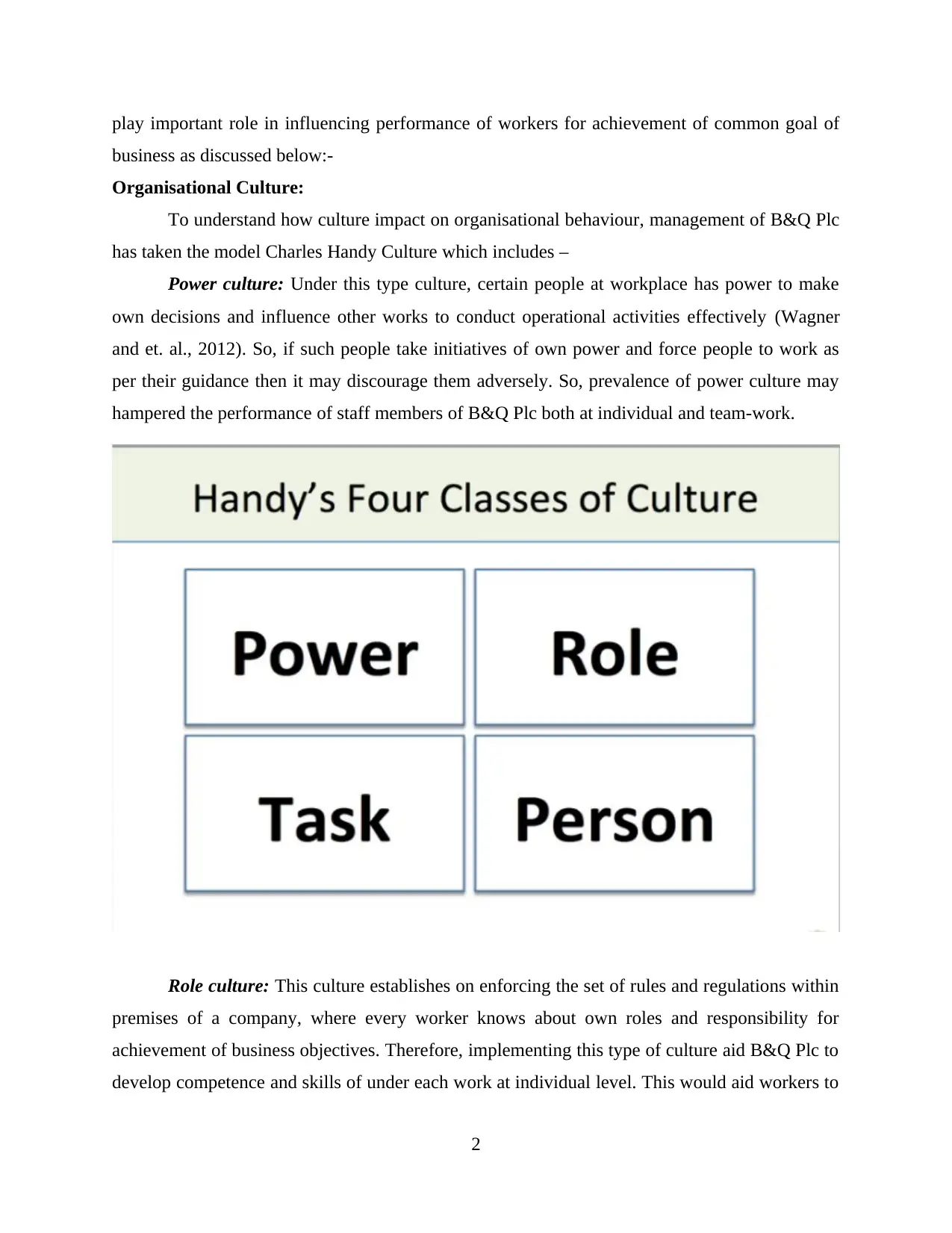
play important role in influencing performance of workers for achievement of common goal of
business as discussed below:-
Organisational Culture:
To understand how culture impact on organisational behaviour, management of B&Q Plc
has taken the model Charles Handy Culture which includes –
Power culture: Under this type culture, certain people at workplace has power to make
own decisions and influence other works to conduct operational activities effectively (Wagner
and et. al., 2012). So, if such people take initiatives of own power and force people to work as
per their guidance then it may discourage them adversely. So, prevalence of power culture may
hampered the performance of staff members of B&Q Plc both at individual and team-work.
Role culture: This culture establishes on enforcing the set of rules and regulations within
premises of a company, where every worker knows about own roles and responsibility for
achievement of business objectives. Therefore, implementing this type of culture aid B&Q Plc to
develop competence and skills of under each work at individual level. This would aid workers to
2
business as discussed below:-
Organisational Culture:
To understand how culture impact on organisational behaviour, management of B&Q Plc
has taken the model Charles Handy Culture which includes –
Power culture: Under this type culture, certain people at workplace has power to make
own decisions and influence other works to conduct operational activities effectively (Wagner
and et. al., 2012). So, if such people take initiatives of own power and force people to work as
per their guidance then it may discourage them adversely. So, prevalence of power culture may
hampered the performance of staff members of B&Q Plc both at individual and team-work.
Role culture: This culture establishes on enforcing the set of rules and regulations within
premises of a company, where every worker knows about own roles and responsibility for
achievement of business objectives. Therefore, implementing this type of culture aid B&Q Plc to
develop competence and skills of under each work at individual level. This would aid workers to
2
Secure Best Marks with AI Grader
Need help grading? Try our AI Grader for instant feedback on your assignments.
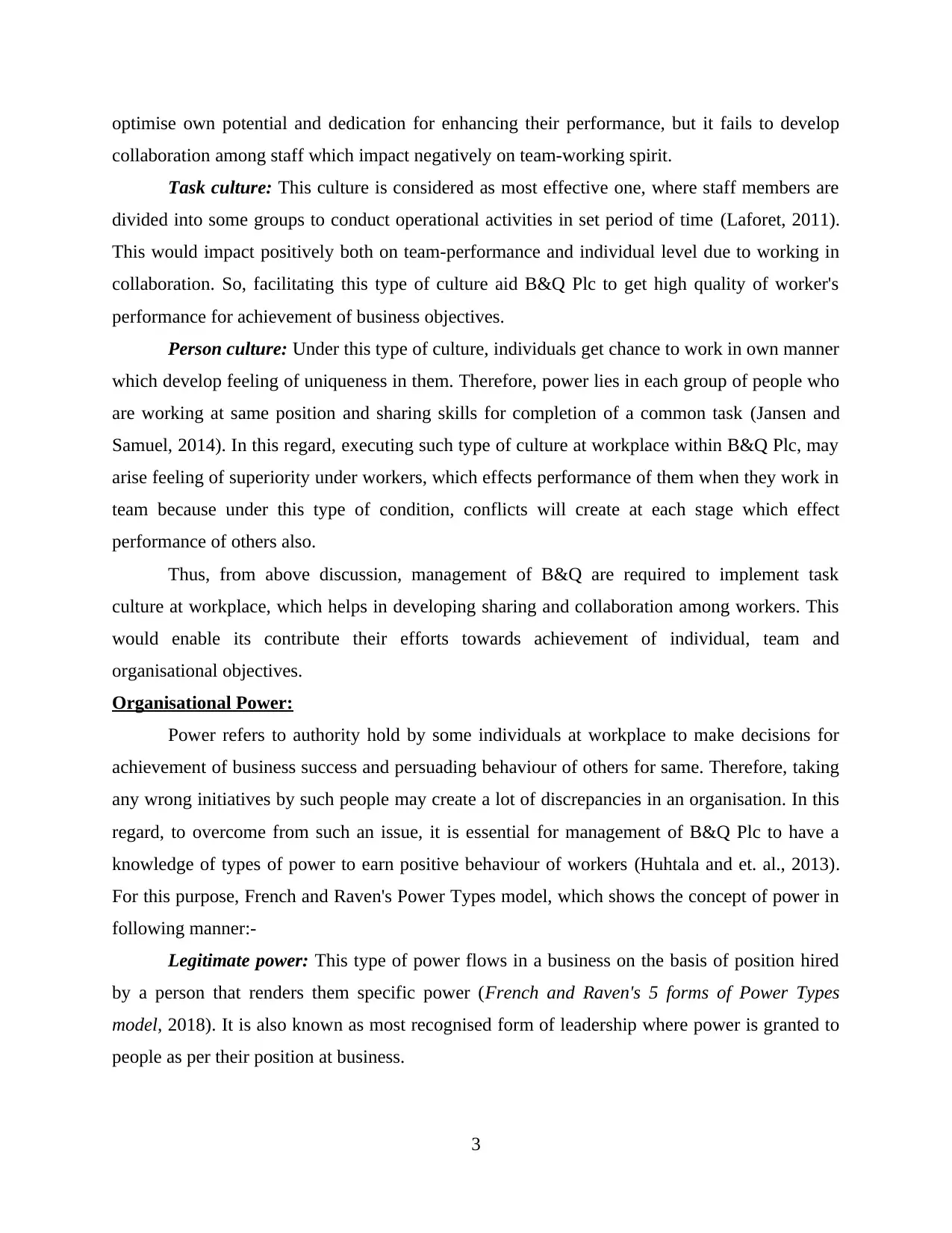
optimise own potential and dedication for enhancing their performance, but it fails to develop
collaboration among staff which impact negatively on team-working spirit.
Task culture: This culture is considered as most effective one, where staff members are
divided into some groups to conduct operational activities in set period of time (Laforet, 2011).
This would impact positively both on team-performance and individual level due to working in
collaboration. So, facilitating this type of culture aid B&Q Plc to get high quality of worker's
performance for achievement of business objectives.
Person culture: Under this type of culture, individuals get chance to work in own manner
which develop feeling of uniqueness in them. Therefore, power lies in each group of people who
are working at same position and sharing skills for completion of a common task (Jansen and
Samuel, 2014). In this regard, executing such type of culture at workplace within B&Q Plc, may
arise feeling of superiority under workers, which effects performance of them when they work in
team because under this type of condition, conflicts will create at each stage which effect
performance of others also.
Thus, from above discussion, management of B&Q are required to implement task
culture at workplace, which helps in developing sharing and collaboration among workers. This
would enable its contribute their efforts towards achievement of individual, team and
organisational objectives.
Organisational Power:
Power refers to authority hold by some individuals at workplace to make decisions for
achievement of business success and persuading behaviour of others for same. Therefore, taking
any wrong initiatives by such people may create a lot of discrepancies in an organisation. In this
regard, to overcome from such an issue, it is essential for management of B&Q Plc to have a
knowledge of types of power to earn positive behaviour of workers (Huhtala and et. al., 2013).
For this purpose, French and Raven's Power Types model, which shows the concept of power in
following manner:-
Legitimate power: This type of power flows in a business on the basis of position hired
by a person that renders them specific power (French and Raven's 5 forms of Power Types
model, 2018). It is also known as most recognised form of leadership where power is granted to
people as per their position at business.
3
collaboration among staff which impact negatively on team-working spirit.
Task culture: This culture is considered as most effective one, where staff members are
divided into some groups to conduct operational activities in set period of time (Laforet, 2011).
This would impact positively both on team-performance and individual level due to working in
collaboration. So, facilitating this type of culture aid B&Q Plc to get high quality of worker's
performance for achievement of business objectives.
Person culture: Under this type of culture, individuals get chance to work in own manner
which develop feeling of uniqueness in them. Therefore, power lies in each group of people who
are working at same position and sharing skills for completion of a common task (Jansen and
Samuel, 2014). In this regard, executing such type of culture at workplace within B&Q Plc, may
arise feeling of superiority under workers, which effects performance of them when they work in
team because under this type of condition, conflicts will create at each stage which effect
performance of others also.
Thus, from above discussion, management of B&Q are required to implement task
culture at workplace, which helps in developing sharing and collaboration among workers. This
would enable its contribute their efforts towards achievement of individual, team and
organisational objectives.
Organisational Power:
Power refers to authority hold by some individuals at workplace to make decisions for
achievement of business success and persuading behaviour of others for same. Therefore, taking
any wrong initiatives by such people may create a lot of discrepancies in an organisation. In this
regard, to overcome from such an issue, it is essential for management of B&Q Plc to have a
knowledge of types of power to earn positive behaviour of workers (Huhtala and et. al., 2013).
For this purpose, French and Raven's Power Types model, which shows the concept of power in
following manner:-
Legitimate power: This type of power flows in a business on the basis of position hired
by a person that renders them specific power (French and Raven's 5 forms of Power Types
model, 2018). It is also known as most recognised form of leadership where power is granted to
people as per their position at business.
3
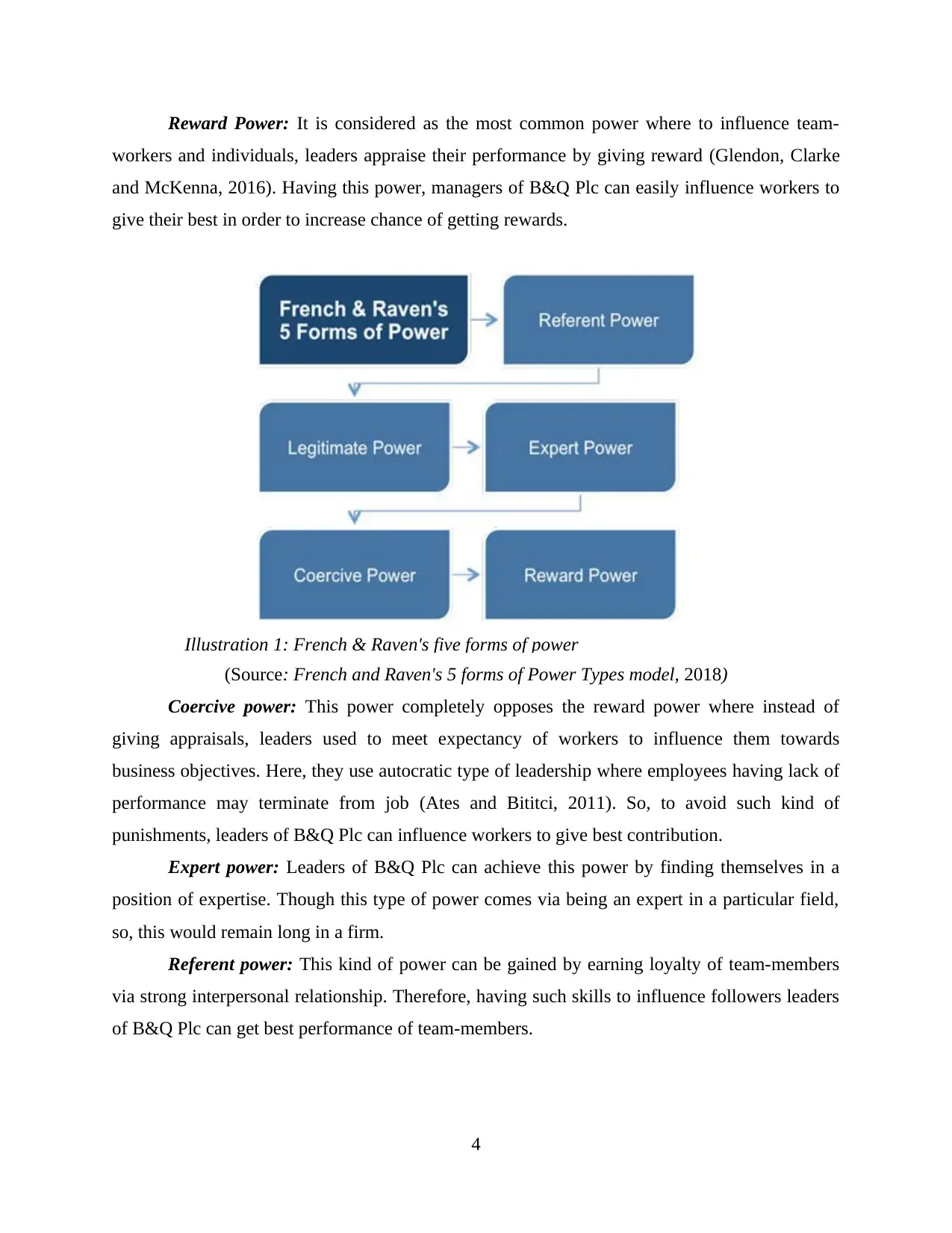
Reward Power: It is considered as the most common power where to influence team-
workers and individuals, leaders appraise their performance by giving reward (Glendon, Clarke
and McKenna, 2016). Having this power, managers of B&Q Plc can easily influence workers to
give their best in order to increase chance of getting rewards.
(Source: French and Raven's 5 forms of Power Types model, 2018)
Coercive power: This power completely opposes the reward power where instead of
giving appraisals, leaders used to meet expectancy of workers to influence them towards
business objectives. Here, they use autocratic type of leadership where employees having lack of
performance may terminate from job (Ates and Bititci, 2011). So, to avoid such kind of
punishments, leaders of B&Q Plc can influence workers to give best contribution.
Expert power: Leaders of B&Q Plc can achieve this power by finding themselves in a
position of expertise. Though this type of power comes via being an expert in a particular field,
so, this would remain long in a firm.
Referent power: This kind of power can be gained by earning loyalty of team-members
via strong interpersonal relationship. Therefore, having such skills to influence followers leaders
of B&Q Plc can get best performance of team-members.
4
Illustration 1: French & Raven's five forms of power
workers and individuals, leaders appraise their performance by giving reward (Glendon, Clarke
and McKenna, 2016). Having this power, managers of B&Q Plc can easily influence workers to
give their best in order to increase chance of getting rewards.
(Source: French and Raven's 5 forms of Power Types model, 2018)
Coercive power: This power completely opposes the reward power where instead of
giving appraisals, leaders used to meet expectancy of workers to influence them towards
business objectives. Here, they use autocratic type of leadership where employees having lack of
performance may terminate from job (Ates and Bititci, 2011). So, to avoid such kind of
punishments, leaders of B&Q Plc can influence workers to give best contribution.
Expert power: Leaders of B&Q Plc can achieve this power by finding themselves in a
position of expertise. Though this type of power comes via being an expert in a particular field,
so, this would remain long in a firm.
Referent power: This kind of power can be gained by earning loyalty of team-members
via strong interpersonal relationship. Therefore, having such skills to influence followers leaders
of B&Q Plc can get best performance of team-members.
4
Illustration 1: French & Raven's five forms of power
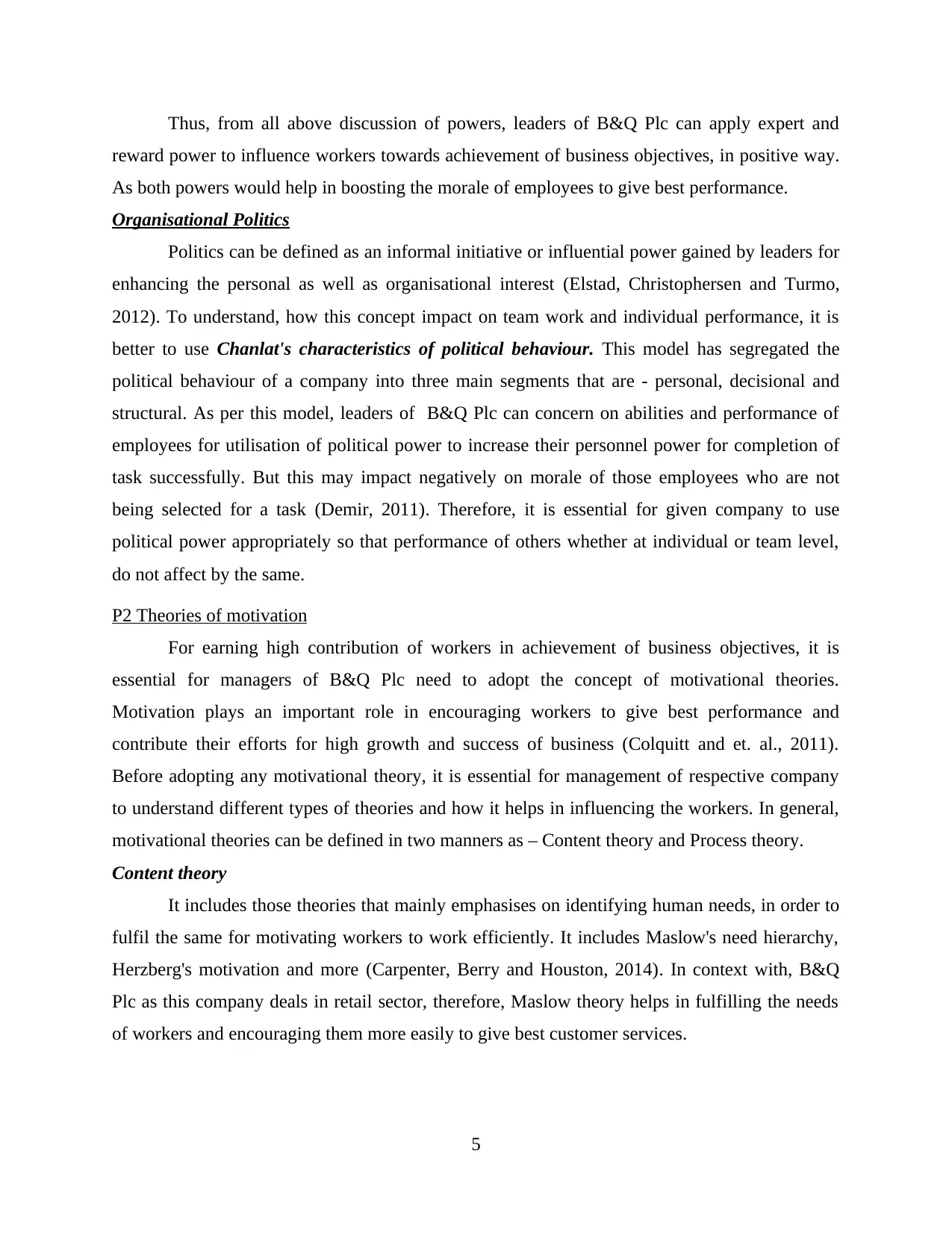
Thus, from all above discussion of powers, leaders of B&Q Plc can apply expert and
reward power to influence workers towards achievement of business objectives, in positive way.
As both powers would help in boosting the morale of employees to give best performance.
Organisational Politics
Politics can be defined as an informal initiative or influential power gained by leaders for
enhancing the personal as well as organisational interest (Elstad, Christophersen and Turmo,
2012). To understand, how this concept impact on team work and individual performance, it is
better to use Chanlat's characteristics of political behaviour. This model has segregated the
political behaviour of a company into three main segments that are - personal, decisional and
structural. As per this model, leaders of B&Q Plc can concern on abilities and performance of
employees for utilisation of political power to increase their personnel power for completion of
task successfully. But this may impact negatively on morale of those employees who are not
being selected for a task (Demir, 2011). Therefore, it is essential for given company to use
political power appropriately so that performance of others whether at individual or team level,
do not affect by the same.
P2 Theories of motivation
For earning high contribution of workers in achievement of business objectives, it is
essential for managers of B&Q Plc need to adopt the concept of motivational theories.
Motivation plays an important role in encouraging workers to give best performance and
contribute their efforts for high growth and success of business (Colquitt and et. al., 2011).
Before adopting any motivational theory, it is essential for management of respective company
to understand different types of theories and how it helps in influencing the workers. In general,
motivational theories can be defined in two manners as – Content theory and Process theory.
Content theory
It includes those theories that mainly emphasises on identifying human needs, in order to
fulfil the same for motivating workers to work efficiently. It includes Maslow's need hierarchy,
Herzberg's motivation and more (Carpenter, Berry and Houston, 2014). In context with, B&Q
Plc as this company deals in retail sector, therefore, Maslow theory helps in fulfilling the needs
of workers and encouraging them more easily to give best customer services.
5
reward power to influence workers towards achievement of business objectives, in positive way.
As both powers would help in boosting the morale of employees to give best performance.
Organisational Politics
Politics can be defined as an informal initiative or influential power gained by leaders for
enhancing the personal as well as organisational interest (Elstad, Christophersen and Turmo,
2012). To understand, how this concept impact on team work and individual performance, it is
better to use Chanlat's characteristics of political behaviour. This model has segregated the
political behaviour of a company into three main segments that are - personal, decisional and
structural. As per this model, leaders of B&Q Plc can concern on abilities and performance of
employees for utilisation of political power to increase their personnel power for completion of
task successfully. But this may impact negatively on morale of those employees who are not
being selected for a task (Demir, 2011). Therefore, it is essential for given company to use
political power appropriately so that performance of others whether at individual or team level,
do not affect by the same.
P2 Theories of motivation
For earning high contribution of workers in achievement of business objectives, it is
essential for managers of B&Q Plc need to adopt the concept of motivational theories.
Motivation plays an important role in encouraging workers to give best performance and
contribute their efforts for high growth and success of business (Colquitt and et. al., 2011).
Before adopting any motivational theory, it is essential for management of respective company
to understand different types of theories and how it helps in influencing the workers. In general,
motivational theories can be defined in two manners as – Content theory and Process theory.
Content theory
It includes those theories that mainly emphasises on identifying human needs, in order to
fulfil the same for motivating workers to work efficiently. It includes Maslow's need hierarchy,
Herzberg's motivation and more (Carpenter, Berry and Houston, 2014). In context with, B&Q
Plc as this company deals in retail sector, therefore, Maslow theory helps in fulfilling the needs
of workers and encouraging them more easily to give best customer services.
5
Paraphrase This Document
Need a fresh take? Get an instant paraphrase of this document with our AI Paraphraser
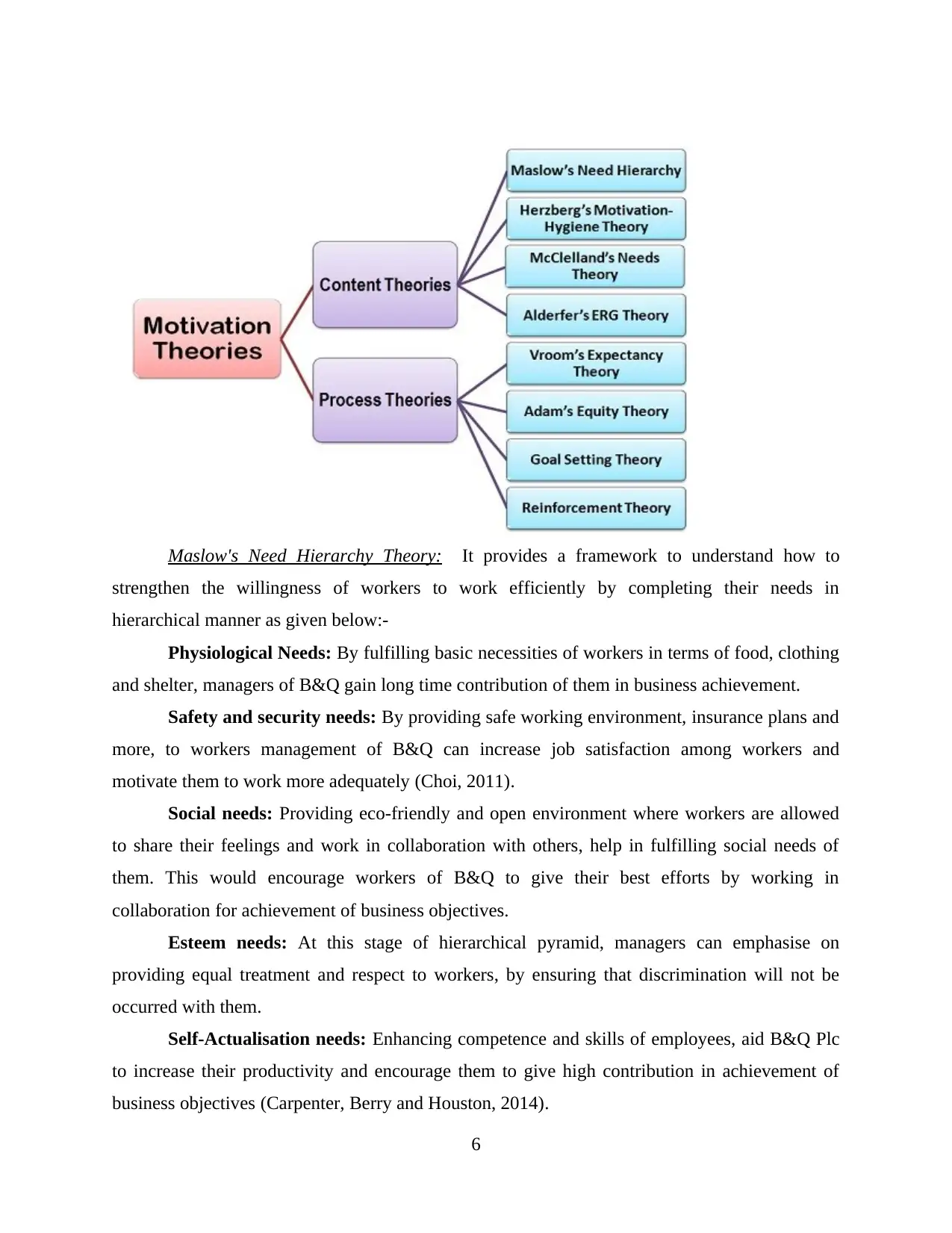
Maslow's Need Hierarchy Theory: It provides a framework to understand how to
strengthen the willingness of workers to work efficiently by completing their needs in
hierarchical manner as given below:-
Physiological Needs: By fulfilling basic necessities of workers in terms of food, clothing
and shelter, managers of B&Q gain long time contribution of them in business achievement.
Safety and security needs: By providing safe working environment, insurance plans and
more, to workers management of B&Q can increase job satisfaction among workers and
motivate them to work more adequately (Choi, 2011).
Social needs: Providing eco-friendly and open environment where workers are allowed
to share their feelings and work in collaboration with others, help in fulfilling social needs of
them. This would encourage workers of B&Q to give their best efforts by working in
collaboration for achievement of business objectives.
Esteem needs: At this stage of hierarchical pyramid, managers can emphasise on
providing equal treatment and respect to workers, by ensuring that discrimination will not be
occurred with them.
Self-Actualisation needs: Enhancing competence and skills of employees, aid B&Q Plc
to increase their productivity and encourage them to give high contribution in achievement of
business objectives (Carpenter, Berry and Houston, 2014).
6
strengthen the willingness of workers to work efficiently by completing their needs in
hierarchical manner as given below:-
Physiological Needs: By fulfilling basic necessities of workers in terms of food, clothing
and shelter, managers of B&Q gain long time contribution of them in business achievement.
Safety and security needs: By providing safe working environment, insurance plans and
more, to workers management of B&Q can increase job satisfaction among workers and
motivate them to work more adequately (Choi, 2011).
Social needs: Providing eco-friendly and open environment where workers are allowed
to share their feelings and work in collaboration with others, help in fulfilling social needs of
them. This would encourage workers of B&Q to give their best efforts by working in
collaboration for achievement of business objectives.
Esteem needs: At this stage of hierarchical pyramid, managers can emphasise on
providing equal treatment and respect to workers, by ensuring that discrimination will not be
occurred with them.
Self-Actualisation needs: Enhancing competence and skills of employees, aid B&Q Plc
to increase their productivity and encourage them to give high contribution in achievement of
business objectives (Carpenter, Berry and Houston, 2014).
6
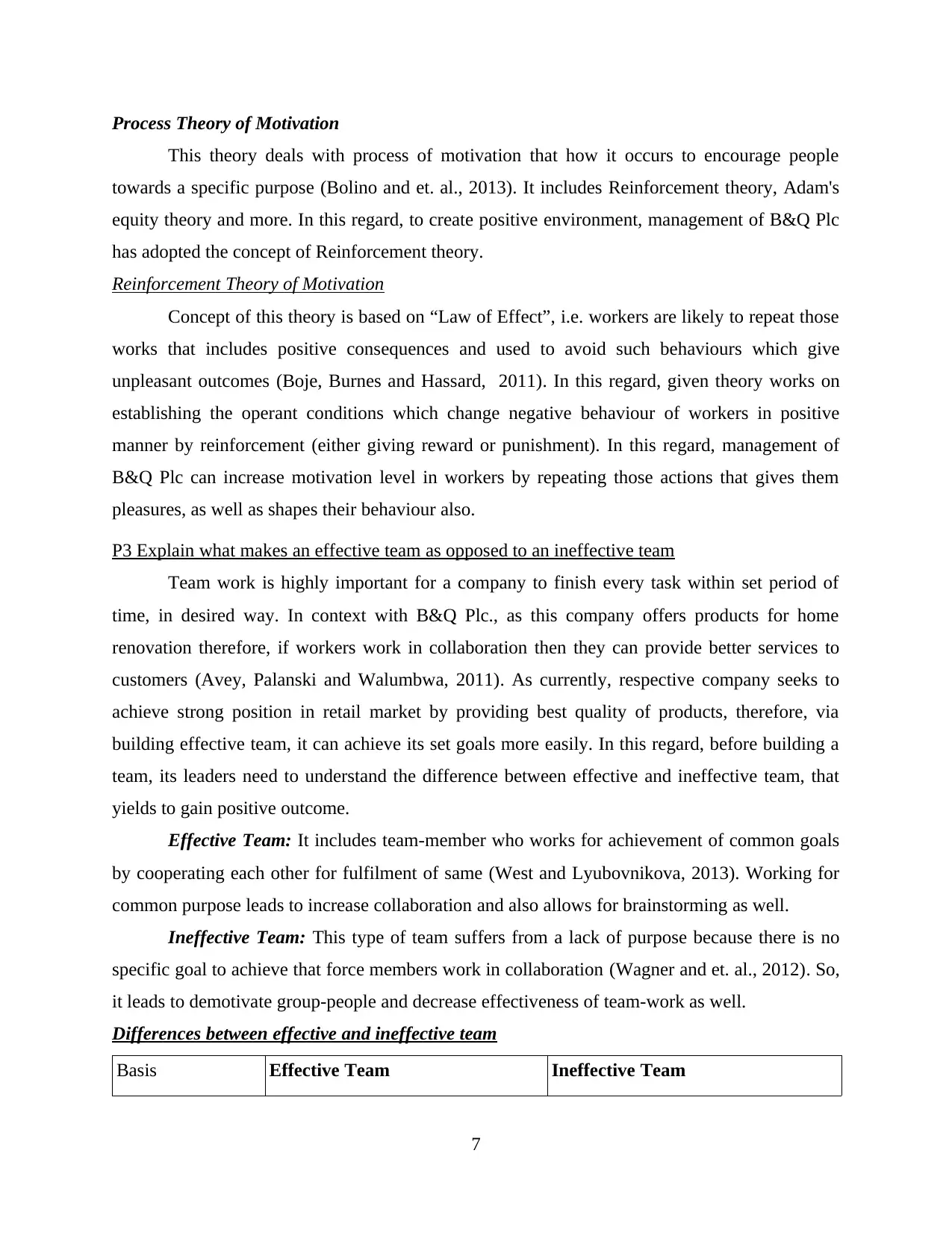
Process Theory of Motivation
This theory deals with process of motivation that how it occurs to encourage people
towards a specific purpose (Bolino and et. al., 2013). It includes Reinforcement theory, Adam's
equity theory and more. In this regard, to create positive environment, management of B&Q Plc
has adopted the concept of Reinforcement theory.
Reinforcement Theory of Motivation
Concept of this theory is based on “Law of Effect”, i.e. workers are likely to repeat those
works that includes positive consequences and used to avoid such behaviours which give
unpleasant outcomes (Boje, Burnes and Hassard, 2011). In this regard, given theory works on
establishing the operant conditions which change negative behaviour of workers in positive
manner by reinforcement (either giving reward or punishment). In this regard, management of
B&Q Plc can increase motivation level in workers by repeating those actions that gives them
pleasures, as well as shapes their behaviour also.
P3 Explain what makes an effective team as opposed to an ineffective team
Team work is highly important for a company to finish every task within set period of
time, in desired way. In context with B&Q Plc., as this company offers products for home
renovation therefore, if workers work in collaboration then they can provide better services to
customers (Avey, Palanski and Walumbwa, 2011). As currently, respective company seeks to
achieve strong position in retail market by providing best quality of products, therefore, via
building effective team, it can achieve its set goals more easily. In this regard, before building a
team, its leaders need to understand the difference between effective and ineffective team, that
yields to gain positive outcome.
Effective Team: It includes team-member who works for achievement of common goals
by cooperating each other for fulfilment of same (West and Lyubovnikova, 2013). Working for
common purpose leads to increase collaboration and also allows for brainstorming as well.
Ineffective Team: This type of team suffers from a lack of purpose because there is no
specific goal to achieve that force members work in collaboration (Wagner and et. al., 2012). So,
it leads to demotivate group-people and decrease effectiveness of team-work as well.
Differences between effective and ineffective team
Basis Effective Team Ineffective Team
7
This theory deals with process of motivation that how it occurs to encourage people
towards a specific purpose (Bolino and et. al., 2013). It includes Reinforcement theory, Adam's
equity theory and more. In this regard, to create positive environment, management of B&Q Plc
has adopted the concept of Reinforcement theory.
Reinforcement Theory of Motivation
Concept of this theory is based on “Law of Effect”, i.e. workers are likely to repeat those
works that includes positive consequences and used to avoid such behaviours which give
unpleasant outcomes (Boje, Burnes and Hassard, 2011). In this regard, given theory works on
establishing the operant conditions which change negative behaviour of workers in positive
manner by reinforcement (either giving reward or punishment). In this regard, management of
B&Q Plc can increase motivation level in workers by repeating those actions that gives them
pleasures, as well as shapes their behaviour also.
P3 Explain what makes an effective team as opposed to an ineffective team
Team work is highly important for a company to finish every task within set period of
time, in desired way. In context with B&Q Plc., as this company offers products for home
renovation therefore, if workers work in collaboration then they can provide better services to
customers (Avey, Palanski and Walumbwa, 2011). As currently, respective company seeks to
achieve strong position in retail market by providing best quality of products, therefore, via
building effective team, it can achieve its set goals more easily. In this regard, before building a
team, its leaders need to understand the difference between effective and ineffective team, that
yields to gain positive outcome.
Effective Team: It includes team-member who works for achievement of common goals
by cooperating each other for fulfilment of same (West and Lyubovnikova, 2013). Working for
common purpose leads to increase collaboration and also allows for brainstorming as well.
Ineffective Team: This type of team suffers from a lack of purpose because there is no
specific goal to achieve that force members work in collaboration (Wagner and et. al., 2012). So,
it leads to demotivate group-people and decrease effectiveness of team-work as well.
Differences between effective and ineffective team
Basis Effective Team Ineffective Team
7
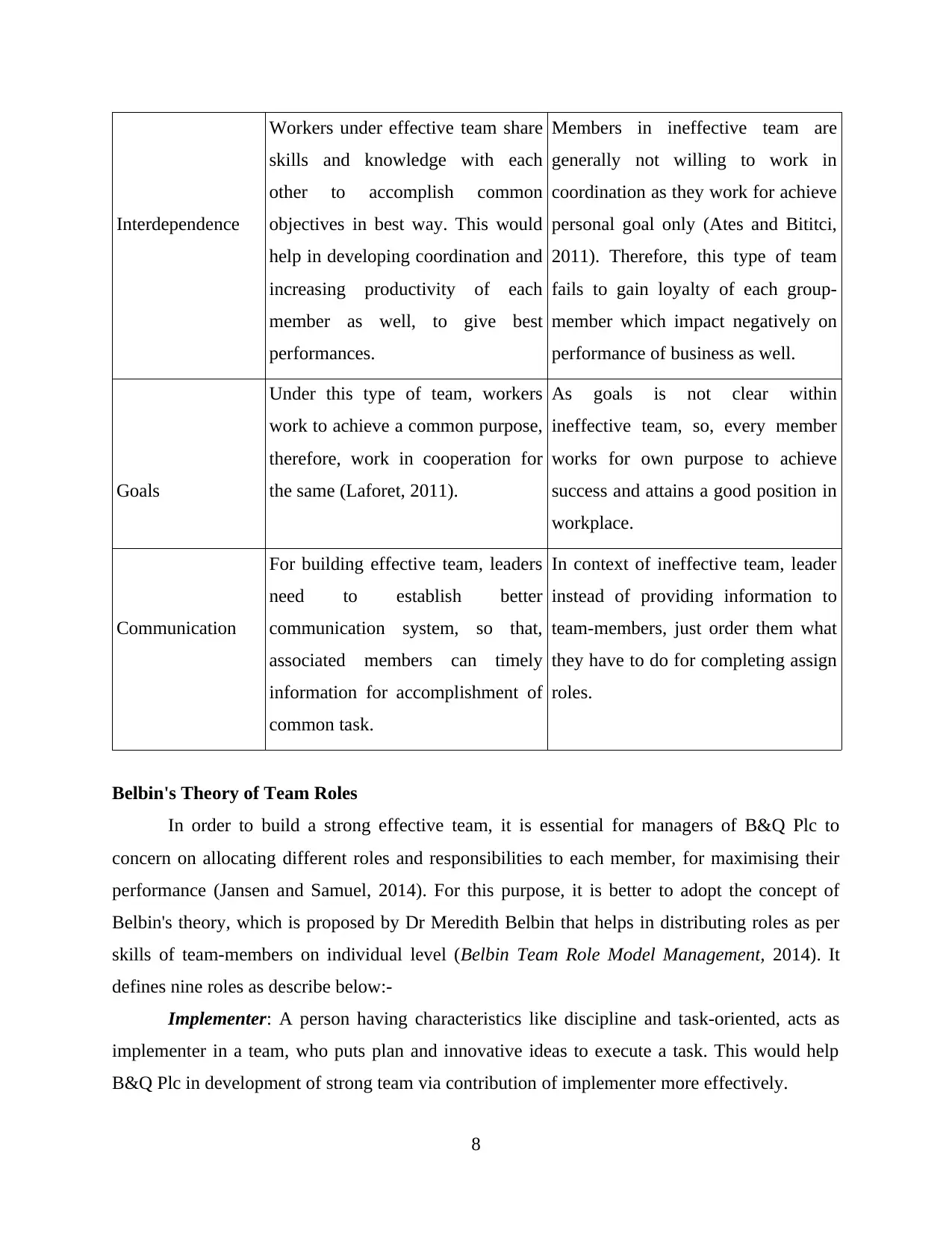
Interdependence
Workers under effective team share
skills and knowledge with each
other to accomplish common
objectives in best way. This would
help in developing coordination and
increasing productivity of each
member as well, to give best
performances.
Members in ineffective team are
generally not willing to work in
coordination as they work for achieve
personal goal only (Ates and Bititci,
2011). Therefore, this type of team
fails to gain loyalty of each group-
member which impact negatively on
performance of business as well.
Goals
Under this type of team, workers
work to achieve a common purpose,
therefore, work in cooperation for
the same (Laforet, 2011).
As goals is not clear within
ineffective team, so, every member
works for own purpose to achieve
success and attains a good position in
workplace.
Communication
For building effective team, leaders
need to establish better
communication system, so that,
associated members can timely
information for accomplishment of
common task.
In context of ineffective team, leader
instead of providing information to
team-members, just order them what
they have to do for completing assign
roles.
Belbin's Theory of Team Roles
In order to build a strong effective team, it is essential for managers of B&Q Plc to
concern on allocating different roles and responsibilities to each member, for maximising their
performance (Jansen and Samuel, 2014). For this purpose, it is better to adopt the concept of
Belbin's theory, which is proposed by Dr Meredith Belbin that helps in distributing roles as per
skills of team-members on individual level (Belbin Team Role Model Management, 2014). It
defines nine roles as describe below:-
Implementer: A person having characteristics like discipline and task-oriented, acts as
implementer in a team, who puts plan and innovative ideas to execute a task. This would help
B&Q Plc in development of strong team via contribution of implementer more effectively.
8
Workers under effective team share
skills and knowledge with each
other to accomplish common
objectives in best way. This would
help in developing coordination and
increasing productivity of each
member as well, to give best
performances.
Members in ineffective team are
generally not willing to work in
coordination as they work for achieve
personal goal only (Ates and Bititci,
2011). Therefore, this type of team
fails to gain loyalty of each group-
member which impact negatively on
performance of business as well.
Goals
Under this type of team, workers
work to achieve a common purpose,
therefore, work in cooperation for
the same (Laforet, 2011).
As goals is not clear within
ineffective team, so, every member
works for own purpose to achieve
success and attains a good position in
workplace.
Communication
For building effective team, leaders
need to establish better
communication system, so that,
associated members can timely
information for accomplishment of
common task.
In context of ineffective team, leader
instead of providing information to
team-members, just order them what
they have to do for completing assign
roles.
Belbin's Theory of Team Roles
In order to build a strong effective team, it is essential for managers of B&Q Plc to
concern on allocating different roles and responsibilities to each member, for maximising their
performance (Jansen and Samuel, 2014). For this purpose, it is better to adopt the concept of
Belbin's theory, which is proposed by Dr Meredith Belbin that helps in distributing roles as per
skills of team-members on individual level (Belbin Team Role Model Management, 2014). It
defines nine roles as describe below:-
Implementer: A person having characteristics like discipline and task-oriented, acts as
implementer in a team, who puts plan and innovative ideas to execute a task. This would help
B&Q Plc in development of strong team via contribution of implementer more effectively.
8
Secure Best Marks with AI Grader
Need help grading? Try our AI Grader for instant feedback on your assignments.
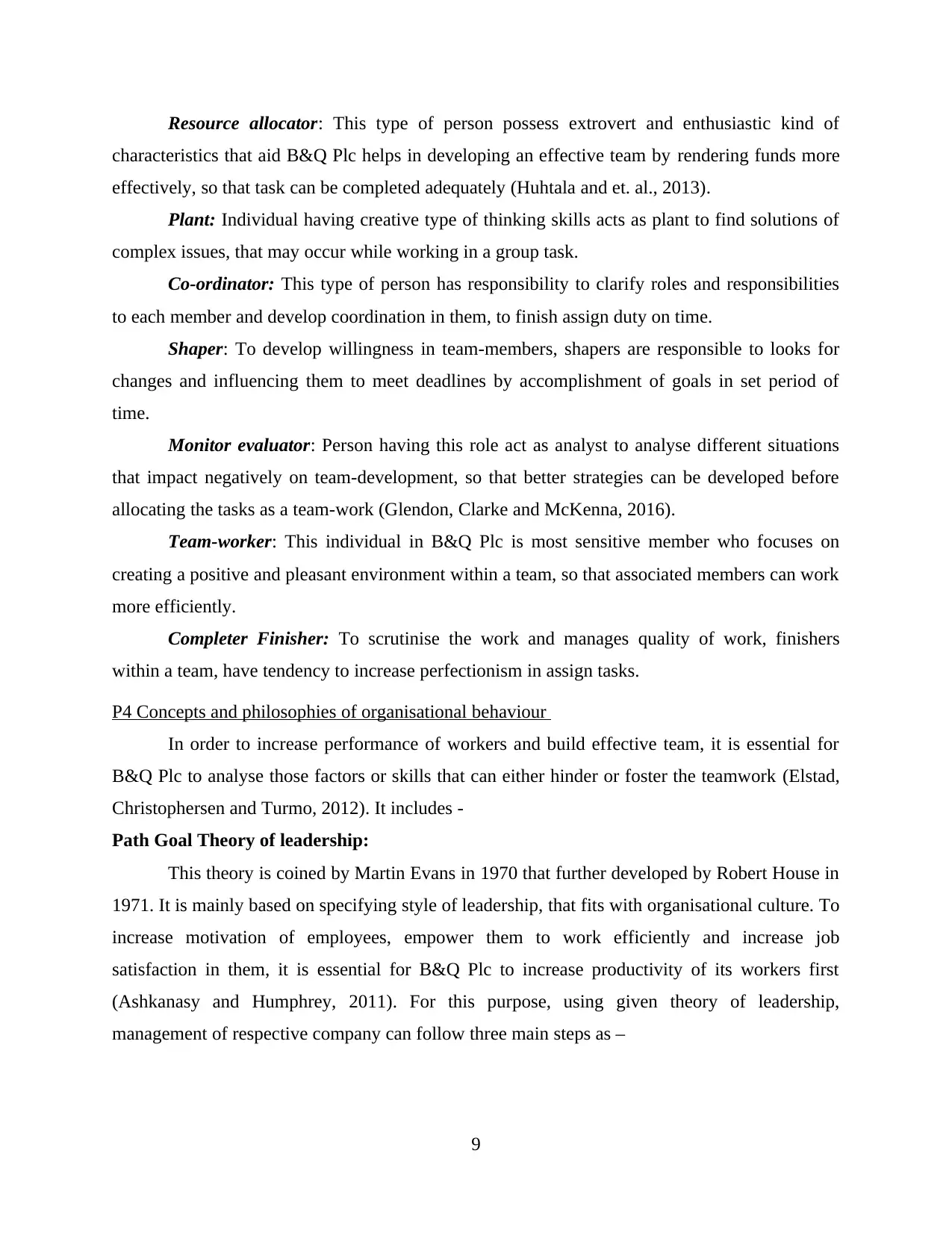
Resource allocator: This type of person possess extrovert and enthusiastic kind of
characteristics that aid B&Q Plc helps in developing an effective team by rendering funds more
effectively, so that task can be completed adequately (Huhtala and et. al., 2013).
Plant: Individual having creative type of thinking skills acts as plant to find solutions of
complex issues, that may occur while working in a group task.
Co-ordinator: This type of person has responsibility to clarify roles and responsibilities
to each member and develop coordination in them, to finish assign duty on time.
Shaper: To develop willingness in team-members, shapers are responsible to looks for
changes and influencing them to meet deadlines by accomplishment of goals in set period of
time.
Monitor evaluator: Person having this role act as analyst to analyse different situations
that impact negatively on team-development, so that better strategies can be developed before
allocating the tasks as a team-work (Glendon, Clarke and McKenna, 2016).
Team-worker: This individual in B&Q Plc is most sensitive member who focuses on
creating a positive and pleasant environment within a team, so that associated members can work
more efficiently.
Completer Finisher: To scrutinise the work and manages quality of work, finishers
within a team, have tendency to increase perfectionism in assign tasks.
P4 Concepts and philosophies of organisational behaviour
In order to increase performance of workers and build effective team, it is essential for
B&Q Plc to analyse those factors or skills that can either hinder or foster the teamwork (Elstad,
Christophersen and Turmo, 2012). It includes -
Path Goal Theory of leadership:
This theory is coined by Martin Evans in 1970 that further developed by Robert House in
1971. It is mainly based on specifying style of leadership, that fits with organisational culture. To
increase motivation of employees, empower them to work efficiently and increase job
satisfaction in them, it is essential for B&Q Plc to increase productivity of its workers first
(Ashkanasy and Humphrey, 2011). For this purpose, using given theory of leadership,
management of respective company can follow three main steps as –
9
characteristics that aid B&Q Plc helps in developing an effective team by rendering funds more
effectively, so that task can be completed adequately (Huhtala and et. al., 2013).
Plant: Individual having creative type of thinking skills acts as plant to find solutions of
complex issues, that may occur while working in a group task.
Co-ordinator: This type of person has responsibility to clarify roles and responsibilities
to each member and develop coordination in them, to finish assign duty on time.
Shaper: To develop willingness in team-members, shapers are responsible to looks for
changes and influencing them to meet deadlines by accomplishment of goals in set period of
time.
Monitor evaluator: Person having this role act as analyst to analyse different situations
that impact negatively on team-development, so that better strategies can be developed before
allocating the tasks as a team-work (Glendon, Clarke and McKenna, 2016).
Team-worker: This individual in B&Q Plc is most sensitive member who focuses on
creating a positive and pleasant environment within a team, so that associated members can work
more efficiently.
Completer Finisher: To scrutinise the work and manages quality of work, finishers
within a team, have tendency to increase perfectionism in assign tasks.
P4 Concepts and philosophies of organisational behaviour
In order to increase performance of workers and build effective team, it is essential for
B&Q Plc to analyse those factors or skills that can either hinder or foster the teamwork (Elstad,
Christophersen and Turmo, 2012). It includes -
Path Goal Theory of leadership:
This theory is coined by Martin Evans in 1970 that further developed by Robert House in
1971. It is mainly based on specifying style of leadership, that fits with organisational culture. To
increase motivation of employees, empower them to work efficiently and increase job
satisfaction in them, it is essential for B&Q Plc to increase productivity of its workers first
(Ashkanasy and Humphrey, 2011). For this purpose, using given theory of leadership,
management of respective company can follow three main steps as –
9
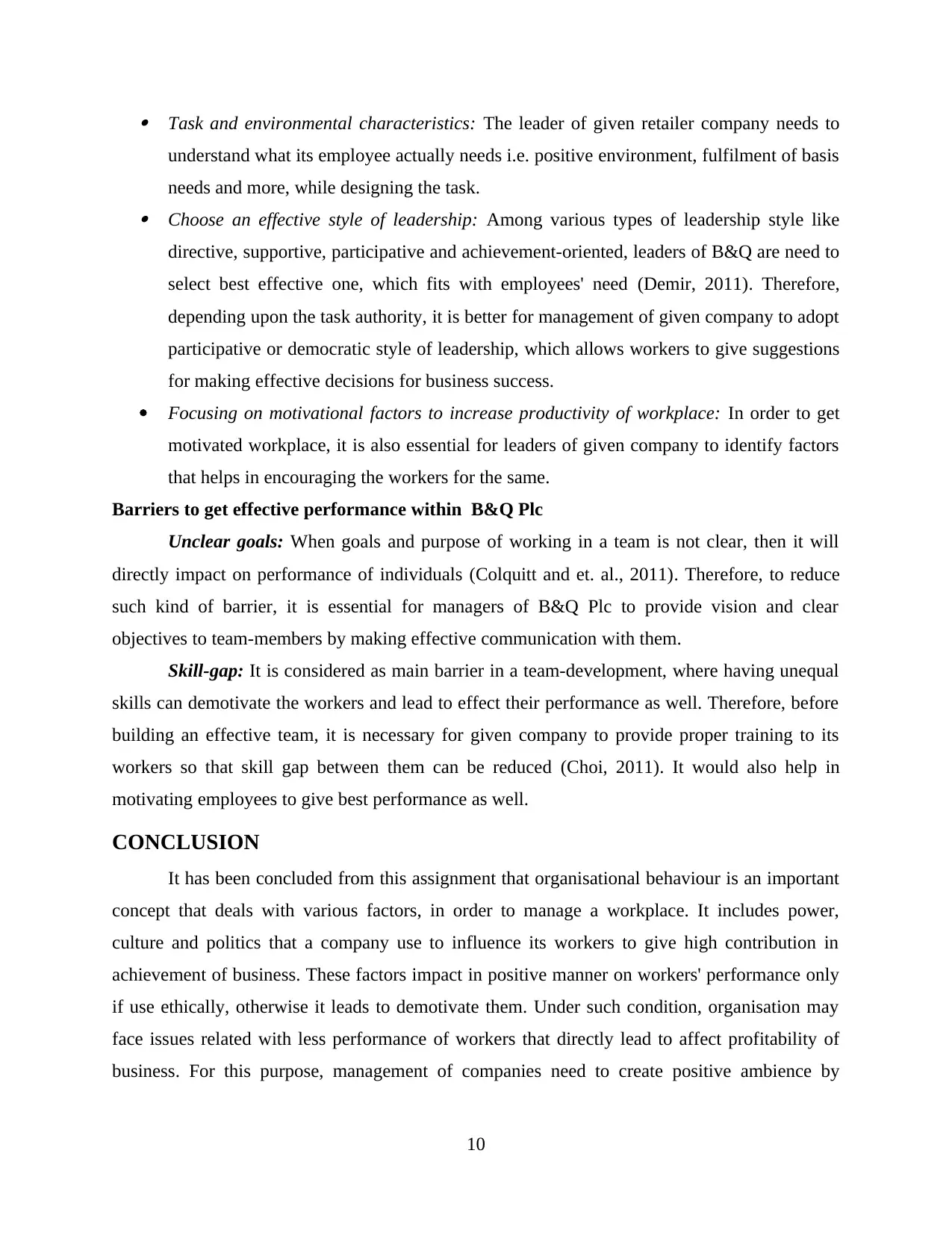
Task and environmental characteristics: The leader of given retailer company needs to
understand what its employee actually needs i.e. positive environment, fulfilment of basis
needs and more, while designing the task. Choose an effective style of leadership: Among various types of leadership style like
directive, supportive, participative and achievement-oriented, leaders of B&Q are need to
select best effective one, which fits with employees' need (Demir, 2011). Therefore,
depending upon the task authority, it is better for management of given company to adopt
participative or democratic style of leadership, which allows workers to give suggestions
for making effective decisions for business success.
Focusing on motivational factors to increase productivity of workplace: In order to get
motivated workplace, it is also essential for leaders of given company to identify factors
that helps in encouraging the workers for the same.
Barriers to get effective performance within B&Q Plc
Unclear goals: When goals and purpose of working in a team is not clear, then it will
directly impact on performance of individuals (Colquitt and et. al., 2011). Therefore, to reduce
such kind of barrier, it is essential for managers of B&Q Plc to provide vision and clear
objectives to team-members by making effective communication with them.
Skill-gap: It is considered as main barrier in a team-development, where having unequal
skills can demotivate the workers and lead to effect their performance as well. Therefore, before
building an effective team, it is necessary for given company to provide proper training to its
workers so that skill gap between them can be reduced (Choi, 2011). It would also help in
motivating employees to give best performance as well.
CONCLUSION
It has been concluded from this assignment that organisational behaviour is an important
concept that deals with various factors, in order to manage a workplace. It includes power,
culture and politics that a company use to influence its workers to give high contribution in
achievement of business. These factors impact in positive manner on workers' performance only
if use ethically, otherwise it leads to demotivate them. Under such condition, organisation may
face issues related with less performance of workers that directly lead to affect profitability of
business. For this purpose, management of companies need to create positive ambience by
10
understand what its employee actually needs i.e. positive environment, fulfilment of basis
needs and more, while designing the task. Choose an effective style of leadership: Among various types of leadership style like
directive, supportive, participative and achievement-oriented, leaders of B&Q are need to
select best effective one, which fits with employees' need (Demir, 2011). Therefore,
depending upon the task authority, it is better for management of given company to adopt
participative or democratic style of leadership, which allows workers to give suggestions
for making effective decisions for business success.
Focusing on motivational factors to increase productivity of workplace: In order to get
motivated workplace, it is also essential for leaders of given company to identify factors
that helps in encouraging the workers for the same.
Barriers to get effective performance within B&Q Plc
Unclear goals: When goals and purpose of working in a team is not clear, then it will
directly impact on performance of individuals (Colquitt and et. al., 2011). Therefore, to reduce
such kind of barrier, it is essential for managers of B&Q Plc to provide vision and clear
objectives to team-members by making effective communication with them.
Skill-gap: It is considered as main barrier in a team-development, where having unequal
skills can demotivate the workers and lead to effect their performance as well. Therefore, before
building an effective team, it is necessary for given company to provide proper training to its
workers so that skill gap between them can be reduced (Choi, 2011). It would also help in
motivating employees to give best performance as well.
CONCLUSION
It has been concluded from this assignment that organisational behaviour is an important
concept that deals with various factors, in order to manage a workplace. It includes power,
culture and politics that a company use to influence its workers to give high contribution in
achievement of business. These factors impact in positive manner on workers' performance only
if use ethically, otherwise it leads to demotivate them. Under such condition, organisation may
face issues related with less performance of workers that directly lead to affect profitability of
business. For this purpose, management of companies need to create positive ambience by
10
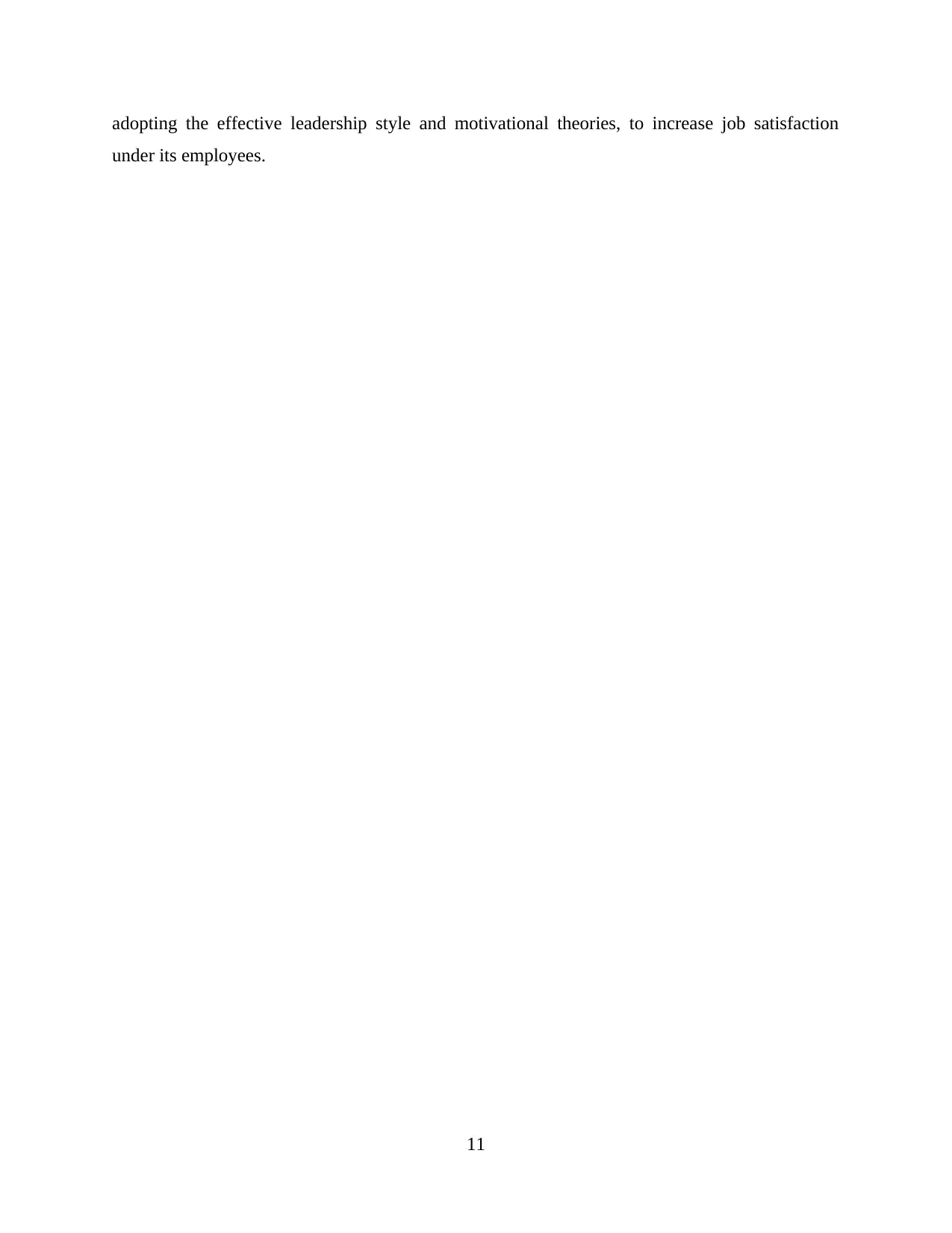
adopting the effective leadership style and motivational theories, to increase job satisfaction
under its employees.
11
under its employees.
11
Paraphrase This Document
Need a fresh take? Get an instant paraphrase of this document with our AI Paraphraser
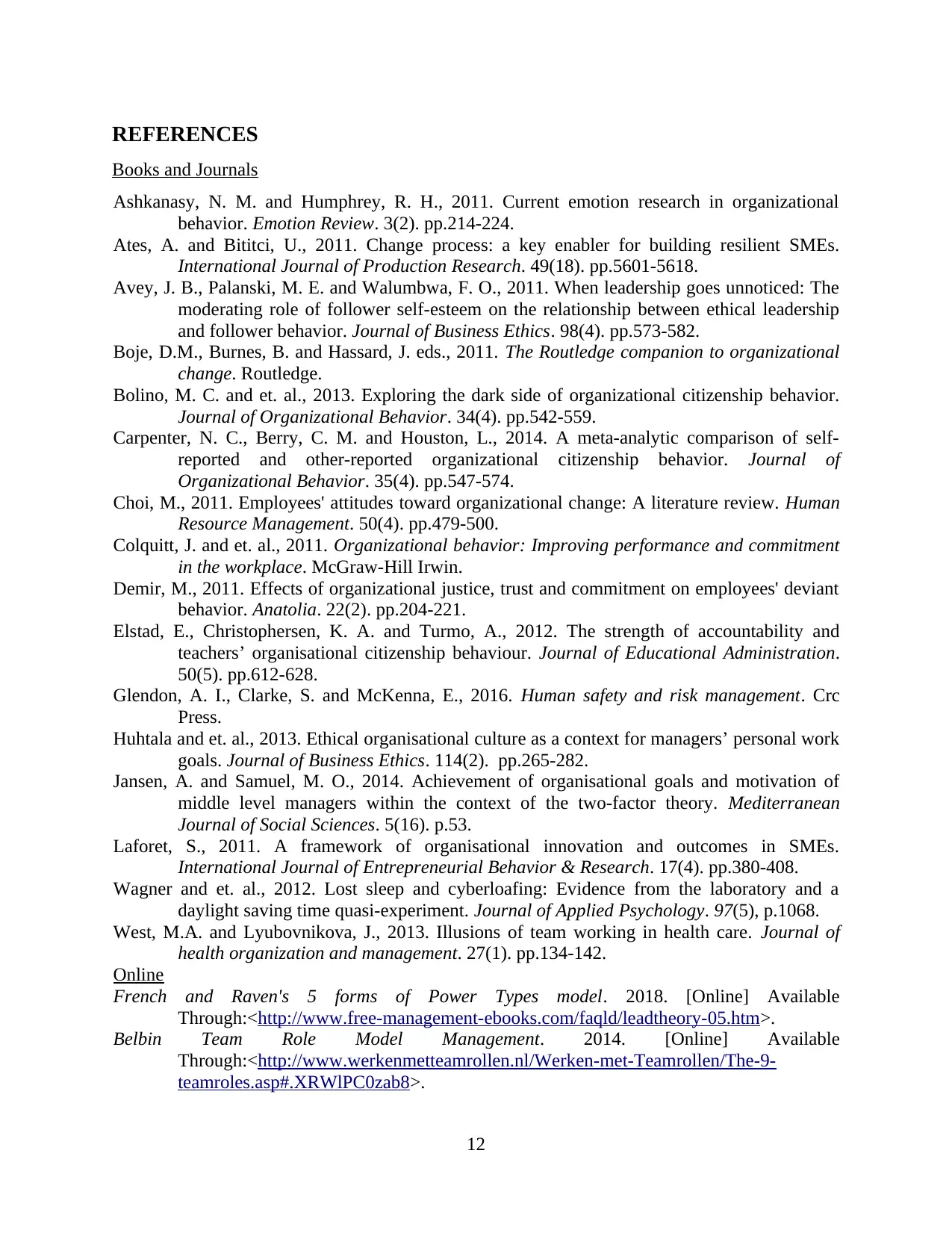
REFERENCES
Books and Journals
Ashkanasy, N. M. and Humphrey, R. H., 2011. Current emotion research in organizational
behavior. Emotion Review. 3(2). pp.214-224.
Ates, A. and Bititci, U., 2011. Change process: a key enabler for building resilient SMEs.
International Journal of Production Research. 49(18). pp.5601-5618.
Avey, J. B., Palanski, M. E. and Walumbwa, F. O., 2011. When leadership goes unnoticed: The
moderating role of follower self-esteem on the relationship between ethical leadership
and follower behavior. Journal of Business Ethics. 98(4). pp.573-582.
Boje, D.M., Burnes, B. and Hassard, J. eds., 2011. The Routledge companion to organizational
change. Routledge.
Bolino, M. C. and et. al., 2013. Exploring the dark side of organizational citizenship behavior.
Journal of Organizational Behavior. 34(4). pp.542-559.
Carpenter, N. C., Berry, C. M. and Houston, L., 2014. A meta‐analytic comparison of self‐
reported and other‐reported organizational citizenship behavior. Journal of
Organizational Behavior. 35(4). pp.547-574.
Choi, M., 2011. Employees' attitudes toward organizational change: A literature review. Human
Resource Management. 50(4). pp.479-500.
Colquitt, J. and et. al., 2011. Organizational behavior: Improving performance and commitment
in the workplace. McGraw-Hill Irwin.
Demir, M., 2011. Effects of organizational justice, trust and commitment on employees' deviant
behavior. Anatolia. 22(2). pp.204-221.
Elstad, E., Christophersen, K. A. and Turmo, A., 2012. The strength of accountability and
teachers’ organisational citizenship behaviour. Journal of Educational Administration.
50(5). pp.612-628.
Glendon, A. I., Clarke, S. and McKenna, E., 2016. Human safety and risk management. Crc
Press.
Huhtala and et. al., 2013. Ethical organisational culture as a context for managers’ personal work
goals. Journal of Business Ethics. 114(2). pp.265-282.
Jansen, A. and Samuel, M. O., 2014. Achievement of organisational goals and motivation of
middle level managers within the context of the two-factor theory. Mediterranean
Journal of Social Sciences. 5(16). p.53.
Laforet, S., 2011. A framework of organisational innovation and outcomes in SMEs.
International Journal of Entrepreneurial Behavior & Research. 17(4). pp.380-408.
Wagner and et. al., 2012. Lost sleep and cyberloafing: Evidence from the laboratory and a
daylight saving time quasi-experiment. Journal of Applied Psychology. 97(5), p.1068.
West, M.A. and Lyubovnikova, J., 2013. Illusions of team working in health care. Journal of
health organization and management. 27(1). pp.134-142.
Online
French and Raven's 5 forms of Power Types model. 2018. [Online] Available
Through:<http://www.free-management-ebooks.com/faqld/leadtheory-05.htm>.
Belbin Team Role Model Management. 2014. [Online] Available
Through:<http://www.werkenmetteamrollen.nl/Werken-met-Teamrollen/The-9-
teamroles.asp#.XRWlPC0zab8>.
12
Books and Journals
Ashkanasy, N. M. and Humphrey, R. H., 2011. Current emotion research in organizational
behavior. Emotion Review. 3(2). pp.214-224.
Ates, A. and Bititci, U., 2011. Change process: a key enabler for building resilient SMEs.
International Journal of Production Research. 49(18). pp.5601-5618.
Avey, J. B., Palanski, M. E. and Walumbwa, F. O., 2011. When leadership goes unnoticed: The
moderating role of follower self-esteem on the relationship between ethical leadership
and follower behavior. Journal of Business Ethics. 98(4). pp.573-582.
Boje, D.M., Burnes, B. and Hassard, J. eds., 2011. The Routledge companion to organizational
change. Routledge.
Bolino, M. C. and et. al., 2013. Exploring the dark side of organizational citizenship behavior.
Journal of Organizational Behavior. 34(4). pp.542-559.
Carpenter, N. C., Berry, C. M. and Houston, L., 2014. A meta‐analytic comparison of self‐
reported and other‐reported organizational citizenship behavior. Journal of
Organizational Behavior. 35(4). pp.547-574.
Choi, M., 2011. Employees' attitudes toward organizational change: A literature review. Human
Resource Management. 50(4). pp.479-500.
Colquitt, J. and et. al., 2011. Organizational behavior: Improving performance and commitment
in the workplace. McGraw-Hill Irwin.
Demir, M., 2011. Effects of organizational justice, trust and commitment on employees' deviant
behavior. Anatolia. 22(2). pp.204-221.
Elstad, E., Christophersen, K. A. and Turmo, A., 2012. The strength of accountability and
teachers’ organisational citizenship behaviour. Journal of Educational Administration.
50(5). pp.612-628.
Glendon, A. I., Clarke, S. and McKenna, E., 2016. Human safety and risk management. Crc
Press.
Huhtala and et. al., 2013. Ethical organisational culture as a context for managers’ personal work
goals. Journal of Business Ethics. 114(2). pp.265-282.
Jansen, A. and Samuel, M. O., 2014. Achievement of organisational goals and motivation of
middle level managers within the context of the two-factor theory. Mediterranean
Journal of Social Sciences. 5(16). p.53.
Laforet, S., 2011. A framework of organisational innovation and outcomes in SMEs.
International Journal of Entrepreneurial Behavior & Research. 17(4). pp.380-408.
Wagner and et. al., 2012. Lost sleep and cyberloafing: Evidence from the laboratory and a
daylight saving time quasi-experiment. Journal of Applied Psychology. 97(5), p.1068.
West, M.A. and Lyubovnikova, J., 2013. Illusions of team working in health care. Journal of
health organization and management. 27(1). pp.134-142.
Online
French and Raven's 5 forms of Power Types model. 2018. [Online] Available
Through:<http://www.free-management-ebooks.com/faqld/leadtheory-05.htm>.
Belbin Team Role Model Management. 2014. [Online] Available
Through:<http://www.werkenmetteamrollen.nl/Werken-met-Teamrollen/The-9-
teamroles.asp#.XRWlPC0zab8>.
12

13
1 out of 15
Related Documents
Your All-in-One AI-Powered Toolkit for Academic Success.
+13062052269
info@desklib.com
Available 24*7 on WhatsApp / Email
![[object Object]](/_next/static/media/star-bottom.7253800d.svg)
Unlock your academic potential
© 2024 | Zucol Services PVT LTD | All rights reserved.





